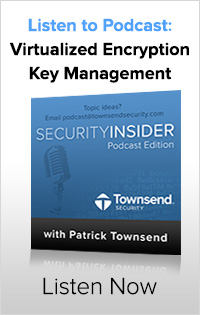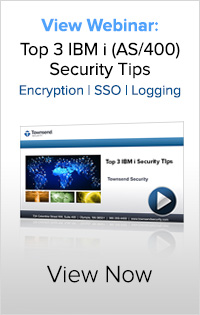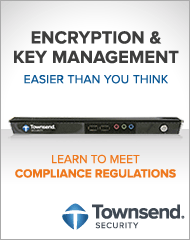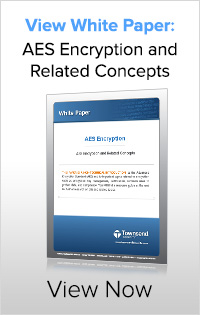… What are people so afraid of?
In motivational bestsellers, Who Moved My Cheese by Spencer Johnson and Sheryl Sandberg's new book Lean In, the question has been posed "What would you do if you weren’t afraid?”
 From that question has come thousands of YouTube video responses, even more posts on social media outlets, and years worth of facilitated group meetings. So I thought of my own question; “what could we do if we weren’t afraid of technology?”
From that question has come thousands of YouTube video responses, even more posts on social media outlets, and years worth of facilitated group meetings. So I thought of my own question; “what could we do if we weren’t afraid of technology?”
Even today, in 2013, there is resistance to moving forward with new cloud technology. I have talked with many prospects about how they currently manage their virtual customer data and most of the time it ends with “well we don’t”.
We recently released a VMware version of our Alliance Key Manager. Alliance Key Manager for VMware allows enterprises to deploy virtualized encryption and key management servers in IT data centers, as well as the cloud.
So now we ponder “why are people afraid of this technology, and what could we help them accomplish if that fear was gone?”
Here at Townsend Security, we can see how some of our prospects and even customers are afraid of these advancements in technology. How in the world is this piece of software going to protect our business and our customer information? Isn’t it easier to reach over to your desk drawer, and pull out that sticky note with your passwords? Or to walk over to the server and manage your system internally? I mean, how do we really know things are going to be safe “out there”?
Well, we’ve got answers to those questions. Advanced technology. Product testing. Accountability. Solid reputation. Trusted products. Dependable support. Testing, testing, and more testing. These are just a few ways to describe Townsend Security’s solution to a virtualized encryption key manager.
As enterprises adopt public and private cloud storage, they bring their sensitive data with them – customer names, email addresses and other personally identifiable information (PII). While compliance regulations require protecting this information, encrypting this data has been a challenge for organizations who want the flexibility and security of a native VMware solution. By deploying Alliance Key Manager for VMware as a vCloud instance, customers can achieve their security and efficiency goals in a cloud environment.
We wouldn’t have advanced this far in technology, if we were all afraid to move forward. Our development team has worked long and hard to make sure your fears will be a thing of the past.
So go ahead already!
Listen to the Podcast: Virtualized Encryption Key Management to hear Patrick Townsend discuss:
-
The benefits of virtualized encryption key management
-
How organizations can use virtualized servers in their data centers and the cloud
-
Special compliance considerations for enterprises who virtualize their infrastructure
-
What Townsend Security is doing to help organizations deploy virtualized encryption key management
After the podcast you can request a product evaluation of our Encryption Key Manager VMWare solution for 30 days and test it out. We offer complimentary 30-day trials of all our solutions, and have a great team of people to walk you through the process… so you have nothing left to fear.





 One of our customers recently submitted a support ticket related to a question asked by their QSA Auditor. Just a quick background on our customer - they have an all IBM i environment and are using AES/400, our NIST-certified AES encryption among other data privacy solutions we offer. This customer needs to comply with PCI because they are accepting credit cards and store personally identifiable information (PII). The question was: How does your AES encryption software prevent unauthorized substitution of cryptographic keys?
One of our customers recently submitted a support ticket related to a question asked by their QSA Auditor. Just a quick background on our customer - they have an all IBM i environment and are using AES/400, our NIST-certified AES encryption among other data privacy solutions we offer. This customer needs to comply with PCI because they are accepting credit cards and store personally identifiable information (PII). The question was: How does your AES encryption software prevent unauthorized substitution of cryptographic keys?


 If you're struggling to understand encryption key management, trust me, you're not alone. If you are just beginning your research, here is the first step to lead you in the direction of a comprehensive key management plan that meets all data security compliance regulations.
If you're struggling to understand encryption key management, trust me, you're not alone. If you are just beginning your research, here is the first step to lead you in the direction of a comprehensive key management plan that meets all data security compliance regulations. PCI DSS. HIPAA/HITECH. State Privacy Laws. What do all these compliance regulations have in common? They require you to be collecting and monitoring your system logs. To give an example of how logging works, if someone tries to sign into an IBM i (or any server) and for whatever reason and the username or password is invalid, that event is logged in the system log. Why is this important? Because if you were to look at this system log in real-time and notice several invalid username and password events, you would say “Hey, our system is being attacked. We need to take action on this now.”
PCI DSS. HIPAA/HITECH. State Privacy Laws. What do all these compliance regulations have in common? They require you to be collecting and monitoring your system logs. To give an example of how logging works, if someone tries to sign into an IBM i (or any server) and for whatever reason and the username or password is invalid, that event is logged in the system log. Why is this important? Because if you were to look at this system log in real-time and notice several invalid username and password events, you would say “Hey, our system is being attacked. We need to take action on this now.” 

 AES Encryption
AES Encryption 
 Recently, Townsend Security hosted a donation drive for the YWCA’s “The Other Bank”. The Other Bank provides items to low income families in Thurston County, where Townsend Security is headquartered. They collect a variety of things to help families in need - for example; diapers, toilet paper, dish soap, deodorant, etc. From the The Other Bank’s website:
Recently, Townsend Security hosted a donation drive for the YWCA’s “The Other Bank”. The Other Bank provides items to low income families in Thurston County, where Townsend Security is headquartered. They collect a variety of things to help families in need - for example; diapers, toilet paper, dish soap, deodorant, etc. From the The Other Bank’s website: Without organizations like The Other Bank, there are a lot of people that would go without. In an earlier blog post this year, I mentioned how great it is to work at a company where the community is so important. It is great to work at a company that not only says they want to make their community better - they actually do it and encourage all of its employees to do the same. Working at Townsend Security has inspired me to be a volunteer at the YWCA and I have put in over 20 hours these past few weeks.
Without organizations like The Other Bank, there are a lot of people that would go without. In an earlier blog post this year, I mentioned how great it is to work at a company where the community is so important. It is great to work at a company that not only says they want to make their community better - they actually do it and encourage all of its employees to do the same. Working at Townsend Security has inspired me to be a volunteer at the YWCA and I have put in over 20 hours these past few weeks.